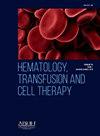TREATMENT OF MYELOFIBROSIS: PRESENT AND FUTURE
IF 1.8
Q3 HEMATOLOGY
引用次数: 0
Abstract
Primary myelofibrosis (PMF) is a myeloproliferative neoplasm characterised by stem cell-derived clonal myeloproliferation often, but not always, accompanied by JAK2, CALR or MPL mutations. It is associated with bone marrow reticulin/collagen fibrosis, abnormal inflammatory cytokine expression, anaemia, hepatosplenomegaly, extramedullary haematopoiesis (EMH), constitutional symptoms, cachexia, risk of leukaemic transformation and shortened survival. Somatic mutations in MPN are classified as ‘driver’ and ‘other’ mutations. Driver mutations are JAK2, CALR and MPL, other mutations are ASXL1, SRSF2, U2AF1, IDH1/2, SF3B1, TET-2, DNMTA3A. SRSF2, ASXL1, and U2AF1-Q157 mutations indicate poor prognosis in PMF. RAS/CBL mutations predict resistance to ruxolitinib treatment. Type 1/like CALR mutation is associated with better survival. The hallmark of MF is the disruption of the JAK/STAT signalling pathway.
TREATMENT
In the treatment approach, allogeneic stem cell transplantation (ASCT) should first be positioned as a priority option. Then, treatment should be planned according to risk stratification for the control of anaemia and improvement of splenomegaly and related symptoms.
The recommended treatment strategy is what we call risk-adaptive treatment, which is treatment according to risk groups and symptoms/symptoms. The general approach is observation in low-risk asymptomatic patients, treatment selection according to symptoms (constitutional findings, splenomegaly, anaemia) in the medium and low risk group, stem cell transplant-based treatment in the high risk group. If additional risk factors are present in the intermediate risk group, ASCT should be considered as an alternative and a patient-based approach should be taken as basis.
In the absence of symptomatic splenomegaly, non-JAK inhibitor drugs may be preferred as first-line treatment for anaemia. Androgens, prednisone (can be used in addition to androgen therapy or alone), danazol, thymodomide, lenalidomide, erythropoiesis-stimulating agents (ESAs) can be used. Although luspatercept is approved for the treatment of anaemia associated with beta thalassaemia and low/intermediate risk MDS, it has been largely ineffective in MF patients. Response rates to each of these drugs range between 15-25%. In the 2nd step, JAK inhibitors, especially momelotinib and pacritinib, can be considered. These drugs exhibit erythropoietic activity as well as favourable effects on splenomegaly and systemic symptoms. Among the available JAKi, Momelotinib shows activity against all three major complications in MF, including anaemia, splenomegaly and constitutional symptoms.
Ruxolitinib (RUX) is the first oral JAK1-2 inhibitor. It received FDA approval in 2011. Long-term data from the COMFORT-I/II studies showed a 30 per cent mortality reduction in intermediate-2/high-risk patients compared to the control group. COMFORT-I and II analyses found that a reduction in spleen size with ruxolitinib treatment correlated with longer survival. Fedratinib (FEDR) received FDA approval in 2019. In the JAKARTA study, FEDR was reported to significantly prolong patients' prognosis compared with placebo. Fedratinib is a treatment option for the treatment of symptoms and splenomegaly or for patients who are resistant or intolerant to ruxolitinib. It includes a warning regarding the potential risk of serious encephalopathy, including Wernicke's encephalopathy. Pacritinib is a selective JAK 2 inhibitor. It received FDA approval in 2022 in moderate-to-high patients. Momelotinib received FDA approval in 2023. JAK1, JAK2 and ACVR1 inhibitor; targets symptoms, splenomegaly and anaemia.
The new therapies, complementary or independent with JAK inhibitors, aim to improve patients' responses and quality of life, going beyond current treatment limitations with a focus on improving anaemia, thrombocytopenia and fibrosis, with an impact on overall survival.
One future combination appears to be Pelabresib + Ruxolitinib. In the MANIFEST II study, the SVR35 response at week 24 was significantly higher in patients assigned to pelabresib+ruxolitinib compared to ruxolitinib alone (66% vs. 35%). At Week 24, at least one degree of improvement in bone marrow fibrosis was seen in 24.2% of patients who received ruxolitinib alone and 38.5% of patients who received pelabresib+ruxolitinib.In conclusion, PELA+RUX shows the potential to improve the four key features of MF with a significant reduction in splenomegaly, improvement in symptom score, improvement in anaemia and reduction in bone marrow (BM) fibrosis at Week 24.
求助全文
约1分钟内获得全文
求助全文
来源期刊

Hematology, Transfusion and Cell Therapy
Multiple-
CiteScore
2.40
自引率
4.80%
发文量
1419
审稿时长
30 weeks
 求助内容:
求助内容: 应助结果提醒方式:
应助结果提醒方式:


